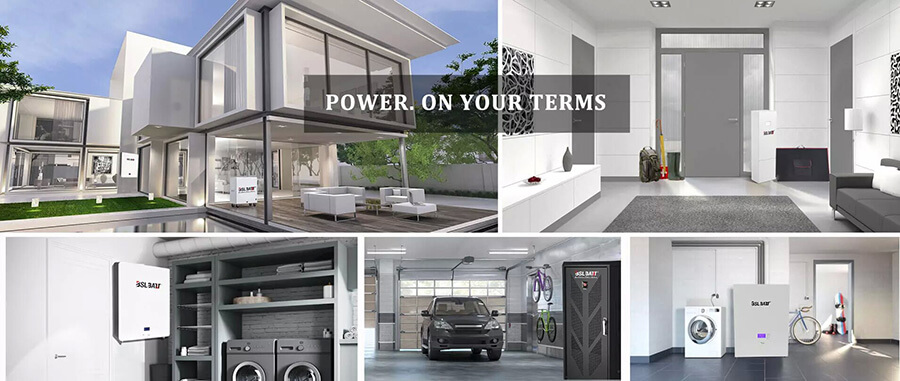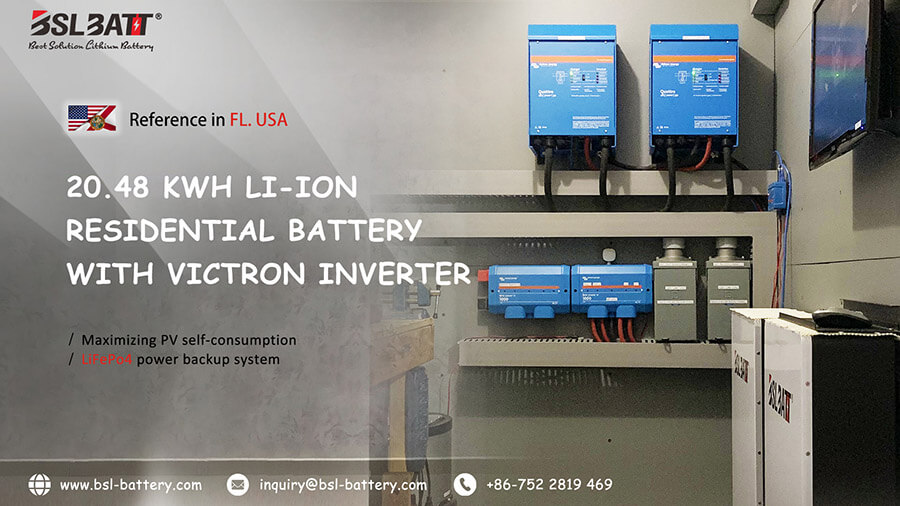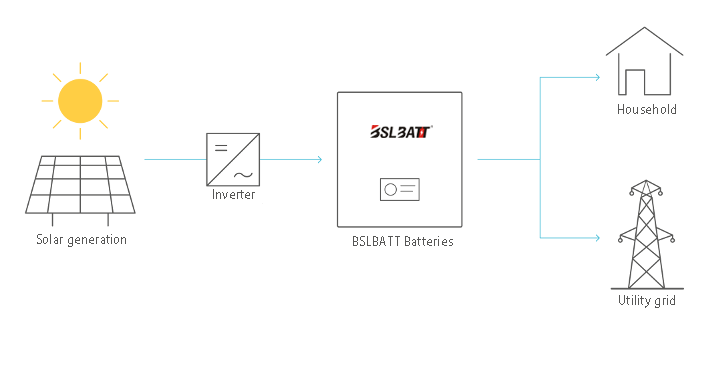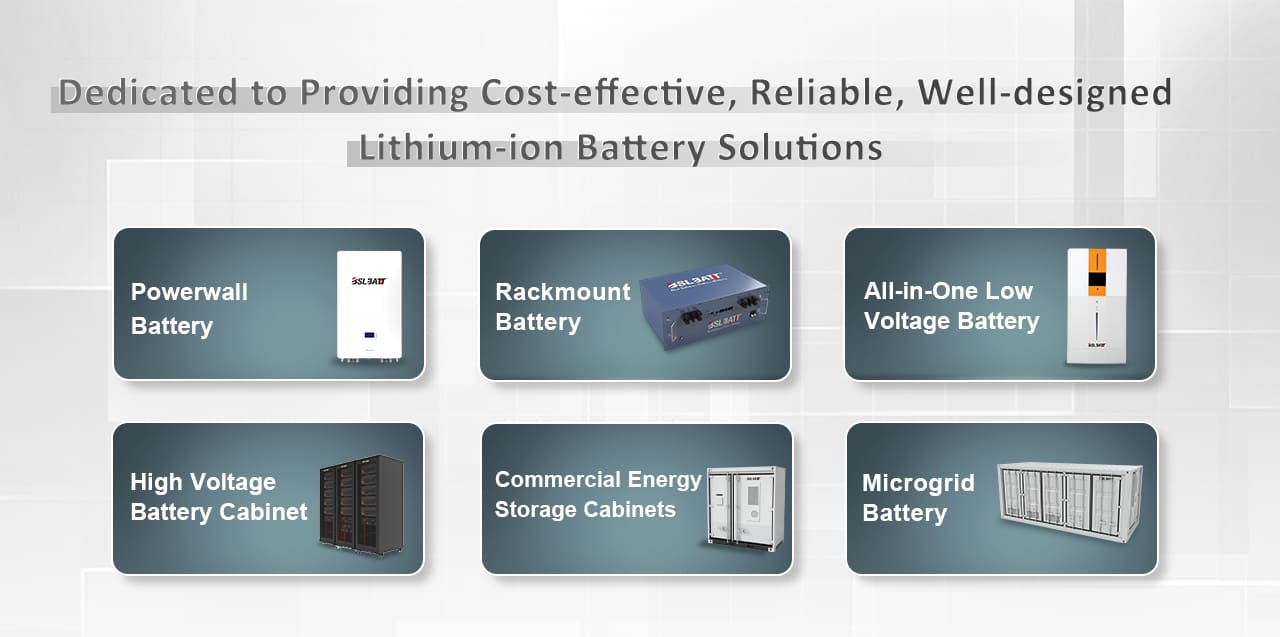What is Home Solar Battery Backup? You have a photovoltaic system and produce your own electricity? Without a home solar battery backup you would have to use the produced solar electricity immediately. This is not very effective, because the electricity is produced during the day, when the sun is shining, but you and your family are not at home. During this time, the electricity demand of most households is low. It is not until the evening hours that demand usually increases significantly. With a home solar battery backup, you can use the solar electricity not used during the day when you really need it. For example, in the evening or at the weekend.  What Exactly Does the Home Solar Battery Backup Do? With an home solar battery backup, you can use more of your self-produced solar electricity on average. You don’t have to feed the electricity into the grid and then buy it back at a later date at a high price. If you manage to store your electricity and use more of your self-produced electricity over time, your electricity costs will drop significantly thanks to significantly increased self-consumption of electricity. Do I Necessarily Need A Residential Battery Storage For My Photovoltaic System? No, photovoltaics also works without residential battery storage. However, in this case you will lose the surplus electricity in high-yield hours for your own consumption. In addition, you have to purchase the electricity from the public grid at times of highest demand. You get paid for the electricity you feed into the grid, but you then spend the money on your purchases. You may even pay more for it than you earn by feeding it into the grid. Therefore, you should strive to use as much of your solar power as possible yourself and therefore buy as little as possible. You can only achieve this with a home battery storage system that matches your photovoltaics and your electricity needs.
What Exactly Does the Home Solar Battery Backup Do? With an home solar battery backup, you can use more of your self-produced solar electricity on average. You don’t have to feed the electricity into the grid and then buy it back at a later date at a high price. If you manage to store your electricity and use more of your self-produced electricity over time, your electricity costs will drop significantly thanks to significantly increased self-consumption of electricity. Do I Necessarily Need A Residential Battery Storage For My Photovoltaic System? No, photovoltaics also works without residential battery storage. However, in this case you will lose the surplus electricity in high-yield hours for your own consumption. In addition, you have to purchase the electricity from the public grid at times of highest demand. You get paid for the electricity you feed into the grid, but you then spend the money on your purchases. You may even pay more for it than you earn by feeding it into the grid. Therefore, you should strive to use as much of your solar power as possible yourself and therefore buy as little as possible. You can only achieve this with a home battery storage system that matches your photovoltaics and your electricity needs.  Storing surplus electricity produced by your photovoltaic panels for later use is an idea worth studying. ● When you are not there and the sun is shining, your panels produce ‘free’ electricity that you do not use because it goes back to the grid. ●Conversely, in the evening, when the sun is down, you pay to draw electricity from the grid. Installing an house battery system can allow you to take advantage of this lost energy. However, it involves a degree of investment and technical constraints. On the other hand, you may be entitled to certain compensations. Furthermore, you should also take into account future developments such as vehicle-to-grid. Advantages of a home Solar Battery 1. For the environment In terms of the supply chain, you can hardly do better than producing your own electricity. However, you need to know that your home battery will not allow you to get through the whole winter on your own reserves. With a battery, you will consume on average 60% to 80% of your own electricity, compared to 50% without (according to Brugel, the regulatory authority for the Brussels’ gas and electricity market). 2. For your wallet With a home battery, you can optimize your electricity needs and purchases. As a producer: ●you store self-produced electricity – which is therefore free – to use it later; ●you avoid ‘selling’ electricity at low prices and then having to buy it back later at the full rate. ●you avoid paying a fee for energy fed back to the grid (does not apply to people living in Brussels); Even without panels, some manufacturers, such as Tesla, maintain that you can buy electricity from the grid when it is cheapest (dual hourly rate for example) and use it later. However, this requires the use of smart meters as well as a smart load balancing. 3. For the electricity grid Consuming locally generated electricity rather than feeding it back into the grid can help manage the balance. In the future, some experts even think domestic batteries could play a buffer role on the smart grid by absorbing renewable production. 4. To ensure a secure supply for you In the event of a power failure, the home battery can be used as backup power. Be careful, though. This use has technical constraints, such as the installation of a specific inverter (see below).
Storing surplus electricity produced by your photovoltaic panels for later use is an idea worth studying. ● When you are not there and the sun is shining, your panels produce ‘free’ electricity that you do not use because it goes back to the grid. ●Conversely, in the evening, when the sun is down, you pay to draw electricity from the grid. Installing an house battery system can allow you to take advantage of this lost energy. However, it involves a degree of investment and technical constraints. On the other hand, you may be entitled to certain compensations. Furthermore, you should also take into account future developments such as vehicle-to-grid. Advantages of a home Solar Battery 1. For the environment In terms of the supply chain, you can hardly do better than producing your own electricity. However, you need to know that your home battery will not allow you to get through the whole winter on your own reserves. With a battery, you will consume on average 60% to 80% of your own electricity, compared to 50% without (according to Brugel, the regulatory authority for the Brussels’ gas and electricity market). 2. For your wallet With a home battery, you can optimize your electricity needs and purchases. As a producer: ●you store self-produced electricity – which is therefore free – to use it later; ●you avoid ‘selling’ electricity at low prices and then having to buy it back later at the full rate. ●you avoid paying a fee for energy fed back to the grid (does not apply to people living in Brussels); Even without panels, some manufacturers, such as Tesla, maintain that you can buy electricity from the grid when it is cheapest (dual hourly rate for example) and use it later. However, this requires the use of smart meters as well as a smart load balancing. 3. For the electricity grid Consuming locally generated electricity rather than feeding it back into the grid can help manage the balance. In the future, some experts even think domestic batteries could play a buffer role on the smart grid by absorbing renewable production. 4. To ensure a secure supply for you In the event of a power failure, the home battery can be used as backup power. Be careful, though. This use has technical constraints, such as the installation of a specific inverter (see below).  Do You Have A Backward Running Meter? If your power meter runs backward or when the so-called compensation model is applied (which is the case in Brussels), a home battery may not be such a good idea. In both cases, the distribution network serves as an immense electric battery. This compensation model is likely to come to an end within a foreseeable time. Only then, buying a home battery will be worth the investment. To Consider Before Investing Cost Currently about € 600/kWh. This price may fall in the future… thanks to the development of the electric car. In fact, batteries whose capacities fall to 80% could be reused in our homes. According to the Blackrock Investment Institute, the price per kWh of batteries should fall to € 420/kWh in 2025. Lifespan 10 years. Current batteries can support at least 5,000 charge cycles, or even more. Storage Capacity Between 4 and 20.5 kWh with 5 to 6 kW of power. As an indication, the average consumption of a household (in Brussels with 4 people) is 9.5 kWh/day. Weights and Dimensions Domestic batteries can weigh more than 120 kg. They can, however, be installed in a service room or discreetly hung on the wall because their design makes them quite flat (about 15 cm against about 1 m high). Technical Constraints Before investing in a home battery, check that it has a built-in inverter, suitable for the use you want to make of it. If it does not, you will need to buy and install an inverter in addition to your battery. In fact, the inverter from your photovoltaic installation is one-way: it transforms the direct current from the panels into alternating current usable for your devices. However, a home battery needs a two-way inverter, as it both charges and discharges. But if you want to use the battery as a back-up power supply in the event of a power failure on the grid, you will need a grid-forming inverter. What is Inside a Home Battery? ●A lithium-ion or lithium-polymer storage battery; ●An electronic control system which makes its operation fully automatic; ●Possibly an inverter to produce alternating current ●A cooling system Home Batteries and Vehicle-to-grid In the future, domestic batteries will probably also play a buffer role on the smart grid by regulating renewable energy flows, What’s more, electric car batteries, which remain unused during the day in car parks, could also be used. This is called vehicle-to-grid. Electric cars could also be used to power the home during the evening, recharging at night at low prices, etc. All this, of course, requires technical and financial management at all times which only a fully automatic system can provide.
Do You Have A Backward Running Meter? If your power meter runs backward or when the so-called compensation model is applied (which is the case in Brussels), a home battery may not be such a good idea. In both cases, the distribution network serves as an immense electric battery. This compensation model is likely to come to an end within a foreseeable time. Only then, buying a home battery will be worth the investment. To Consider Before Investing Cost Currently about € 600/kWh. This price may fall in the future… thanks to the development of the electric car. In fact, batteries whose capacities fall to 80% could be reused in our homes. According to the Blackrock Investment Institute, the price per kWh of batteries should fall to € 420/kWh in 2025. Lifespan 10 years. Current batteries can support at least 5,000 charge cycles, or even more. Storage Capacity Between 4 and 20.5 kWh with 5 to 6 kW of power. As an indication, the average consumption of a household (in Brussels with 4 people) is 9.5 kWh/day. Weights and Dimensions Domestic batteries can weigh more than 120 kg. They can, however, be installed in a service room or discreetly hung on the wall because their design makes them quite flat (about 15 cm against about 1 m high). Technical Constraints Before investing in a home battery, check that it has a built-in inverter, suitable for the use you want to make of it. If it does not, you will need to buy and install an inverter in addition to your battery. In fact, the inverter from your photovoltaic installation is one-way: it transforms the direct current from the panels into alternating current usable for your devices. However, a home battery needs a two-way inverter, as it both charges and discharges. But if you want to use the battery as a back-up power supply in the event of a power failure on the grid, you will need a grid-forming inverter. What is Inside a Home Battery? ●A lithium-ion or lithium-polymer storage battery; ●An electronic control system which makes its operation fully automatic; ●Possibly an inverter to produce alternating current ●A cooling system Home Batteries and Vehicle-to-grid In the future, domestic batteries will probably also play a buffer role on the smart grid by regulating renewable energy flows, What’s more, electric car batteries, which remain unused during the day in car parks, could also be used. This is called vehicle-to-grid. Electric cars could also be used to power the home during the evening, recharging at night at low prices, etc. All this, of course, requires technical and financial management at all times which only a fully automatic system can provide.  Why Have You Chosen BSLBATT As A Partner? “We started using BSLBATT because they had a solid reputation and track record of supplying energy storage systems for a wide array of applications. Since using them, we’ve found that they are extremely reliable and the company’s customer service is unmatched. Our priority is being confident that our customers can rely on the systems we install, and using BSLBATT batteries has helped us achieve that. Their responsive customer service teams allow us to provide the exceptional service to our clients that we pride ourselves on, and they are often the most competitively priced on the market. BSLBATT also offers a variety of capacities, which is helpful to our customers who often have varying needs, depending on if they are intending to power small systems or full-time systems.” What are The Most Popular BSLBATT Battery Models and Why Do They Work So Well with Your Systems? “Most of our customers require either a 48V Rack Mount Lithium Battery or 48V Solar Wall Lithium Battery, so our biggest sellers are the B-LFP48-100, B-LFP48-130, B-LFP48-160, B-LFP48-200, LFP48-100PW, and B-LFP48-200PW batteries. These options provide the best support for solar-plus-storage systems because of their capacity – they have up to 50 percent more capacity and last much longer than lead acid options. For our customers with lower capacity needs, the 12 volt power systems are suitable and we recommend the B-LFP12-100 – B-LFP12-300. Additionally, it’s a great benefit to have the Low-Temperature line available for customers using lithium batteries in colder climates.”
Why Have You Chosen BSLBATT As A Partner? “We started using BSLBATT because they had a solid reputation and track record of supplying energy storage systems for a wide array of applications. Since using them, we’ve found that they are extremely reliable and the company’s customer service is unmatched. Our priority is being confident that our customers can rely on the systems we install, and using BSLBATT batteries has helped us achieve that. Their responsive customer service teams allow us to provide the exceptional service to our clients that we pride ourselves on, and they are often the most competitively priced on the market. BSLBATT also offers a variety of capacities, which is helpful to our customers who often have varying needs, depending on if they are intending to power small systems or full-time systems.” What are The Most Popular BSLBATT Battery Models and Why Do They Work So Well with Your Systems? “Most of our customers require either a 48V Rack Mount Lithium Battery or 48V Solar Wall Lithium Battery, so our biggest sellers are the B-LFP48-100, B-LFP48-130, B-LFP48-160, B-LFP48-200, LFP48-100PW, and B-LFP48-200PW batteries. These options provide the best support for solar-plus-storage systems because of their capacity – they have up to 50 percent more capacity and last much longer than lead acid options. For our customers with lower capacity needs, the 12 volt power systems are suitable and we recommend the B-LFP12-100 – B-LFP12-300. Additionally, it’s a great benefit to have the Low-Temperature line available for customers using lithium batteries in colder climates.”
Post time: May-08-2024








